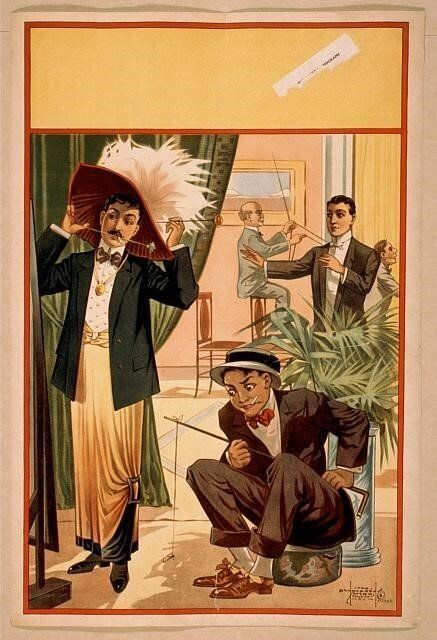Hypnotized And On Display

Herein is presented an unusual local story of which, unfortunately, little else is known except what was reported in the Quincy newspapers at that time. The preservation of these papers on the Quincy Public Library’s online newspaper archive allows us to learn about these little known, short-lived but fascinating events. Without this archive, they would be lost to us.
On Tuesday, April 6, 1897, a hypnotist who billed himself as Professor Laska, came to town to entertain at the Empire Theater, formerly at 111 North 8th Street. At the end of his performance that night near 10:00 pm, Laska and the audience walked out of the theater, got in their cars or wagons, and rode three blocks west on Maine Street and one block north to Stern’s Department Store building on 5th and Hampshire Streets. A large crowd of 2,000 local people were massed around the store, “blockading the sidewalk, filling the street, and stretching far into [Washington] park”, according to the Quincy Whig on April 8, 1897. They had read the announcements in the Quincy papers about the professor’s upcoming public exhibition of his hypnotic powers in Stern’s large storefront display window and had come to watch.
Charles H. Hensler of 1124 North 8th Street, who worked as a porter at the St. James Hotel, two blocks from the Empire Theater on 6th Street, had agreed to be hypnotized by Professor Laska in Stern’s window and remain there for forty-eight hours, during which time he would receive no food or water.
The crowd watched intently as Professor Laska put Hensler into a hypnotic sleep that Tuesday evening in Quincy. There he slept overnight, all day Wednesday, all day Thursday, and into the Thursday evening. He slept as horses and carriages trotted past Stern’s Department Store while other downtown business was carried on each day. He slept as customers gawked through the store window, then came in and shopped, possibly for one of Stern’s $10 Easter suits so heavily advertised. He slept despite the attempts of some passers-by to rouse him.
The Quincy Whig on April 7, 1897, allotted some page-one space to the story on that Wednesday, reporting that Hensler was “sleeping quietly and naturally,” according to the two physicians who were on duty to observe him. The article also stated that Hensler was “insensible to pain” while under hypnosis, as a needle had been “passed through the lobe of one of his ears failing to have the slightest effect on the sleeping man.”
Stern’s showcase window had become quite a show for those two days as the Quincy Whig also reported that Charles Stern, the store owner, “and several other well-known citizens were present in the show window,” presumably to witness the needle being poked through Hensler’s earlobe. One can also assume that Stern’s sold more clothes during those weekdays than usual, with the sleeping man stunt in the store window drawing more shoppers.
While he slept in public view, Hensler missed the Quincy Whig’s report that same Wednesday on the “disgracefully obnoxious” behavior of Adams County Sheriff Gus Roth at the Fourth Precinct polling place near Fifth and Vermont Streets during the city election the night before. Roth electioneered inside and “played the part of the election thug and plug-ugly,” ignoring repeated requests from election officials to stop. John Steinbach was re-elected mayor of Quincy that Tuesday in 1897.
Hensler also slept through the continuing coverage in all the Quincy papers of the rising level of the Mississippi River due to recent heavy rainfall. “The Raging Waters” was the title the Quincy Daily Journal gave to its article in in the Thursday, April 8, 1897 paper, referring to “the crucial test of the levees.” Even the steady rain hitting Stern’s store window that day did not wake Charles Hensler.
Nearing the end of his two days of hypnotic sleep that Thursday evening, Hensler was taken the four blocks back to the Empire Theater to be brought out of his trance by Professor Laska in front of a paying crowd. Attendance was lighter than Tuesday’s gathering, the novelty apparently having waned. “He awoke like any man after a good rest, and after the professor had yelled at him several times,” reported the April 9, 1897 Quincy Journal with a tinge of disappointment. The Professor’s act prior to the awakening was deemed the better part of the evening’s entertainment although some suspected that those hypnotized that night on stage had been rehearsed. The Quincy Journal went on to describe Laska as “a poor talker, and his … words, frequently indistinctly spoken, [were] a bore to his audience.” Still, as the Quincy Daily Journal in their April 9, 1897 story stated, “[T]he audience enjoyed it all, and everybody was satisfied.”
Laska returned in 1899 to perform at the St. James. Charles Hensler missed those shows by a few days, having begun a three-year hitch with the army. He returned to Quincy, married, and in his older age, became a resident of the Soldiers’ and Sailors’ Home. The Home has no record of his death. No obituary or grave could be located for either man today.
Greg Kreinberg is a Quincy native who worked in his father's grocery store and graduated from Quincy College. Since moving to Chicago he has been a full-time educator and a part-time writer.
SOURCES
“Brevities.” Quincy Whig, April 8, 1897, 8.
“Easter Sunday.” (ad for Stern’s). Quincy Whig, April 6, 1897, 4.
“Gus Roth, the Bully Again.” Quincy Whig, April 7, 1897, p. 8.
“Licensed to Wed.” Quincy Daily Journal, October 23, 1908, p. 7.
“Plays and Players.” Quincy Daily Journal, April 9, 1897, 5.
“Quincy Warriors.” Quincy Daily Journal, March 18, 1899, p. 7.
“The Raging Waters.” Quincy Daily Journal, April 8, 1897, 2.
“Sleeping Very Sound.” Quincy Whig, April 7, 1897, 1.
“Waked Up the Sleeper.” Quincy Whig, April 9, 1897, p.3.







